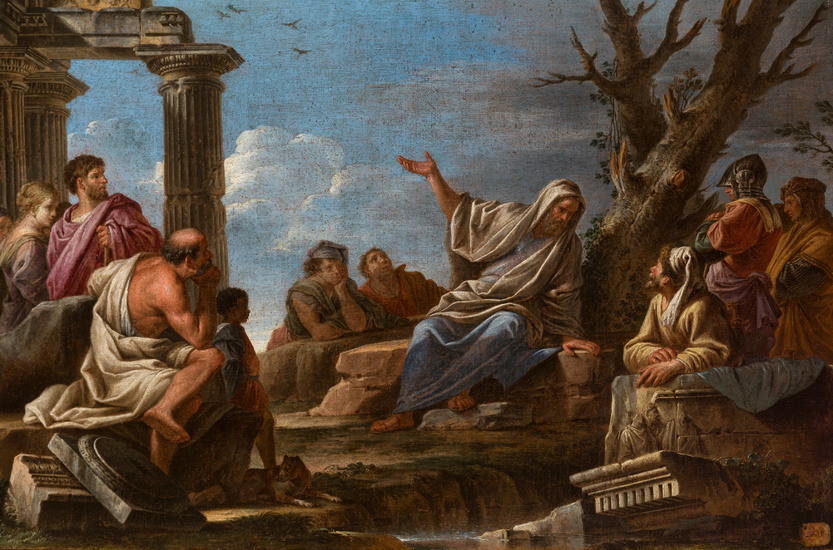Attributed to Giovanni Paolo Panini
Attributed to GIOVANNI PAOLO PANINI (Piacenza, Emilia-Romagna, 1691 - Rome, 1765).
"St. Paul in the Areopagus of Athens".
Oil on canvas.
It has Italian frame of the eighteenth century.
Provenance: Infante Sebastián Gabriel de Borbón.
Measurements: 48 x 72 cm; 65 x 89 cm (frame).
The composition of this scene follows a triangular pattern of classical character. This allows an easy reading of the theme represented. It is worth mentioning the treatment of color, with a palette of bright and saturated colors that brings expressiveness to the work, thus harmonizing with the subject matter represented and which was a common characteristic in the Spanish Mannerist school.
St. Paul was a Hellenized Jew from the Diaspora, born in Tarsus. He was therefore Jewish by ethnicity, Greek by culture and Roman by nationality. He received the name Saul, which he changed to Paul after his conversion. Born at the beginning of the first century, he studied in Jerusalem with Rabbi Gamaliel, who was known for his hatred of Christians. One day, when around the year 35 he was on his way from Jerusalem to Damascus, he was dazzled by lightning and fell from his horse. Then he heard the voice of Jesus saying to him: "Saul, Saul, why are you persecuting me? As a result of this experience, the saint went abruptly from persecutor to zealot of Christianity. After curing the blindness of a Christian from Damascus, he began his life as a missionary, until he arrived in Jerusalem where he came into contact with Peter and the other apostles. In the Middle Ages numerous corporations were placed under his patronage, due to different aspects of his iconography, life and miracles. However, St. Paul was never a popular saint, which proves the relative poverty of his iconography. In fact, the role he occupies in art is out of proportion to his importance in the spread of Christianity. In early Christian art, his only attributes are a book or a scroll, and in the 13th century his emblem appears, the sword that was the instrument of his martyrdom.
HELP
View it on
Estimate
Time
Auction House
Attributed to GIOVANNI PAOLO PANINI (Piacenza, Emilia-Romagna, 1691 - Rome, 1765).
"St. Paul in the Areopagus of Athens".
Oil on canvas.
It has Italian frame of the eighteenth century.
Provenance: Infante Sebastián Gabriel de Borbón.
Measurements: 48 x 72 cm; 65 x 89 cm (frame).
The composition of this scene follows a triangular pattern of classical character. This allows an easy reading of the theme represented. It is worth mentioning the treatment of color, with a palette of bright and saturated colors that brings expressiveness to the work, thus harmonizing with the subject matter represented and which was a common characteristic in the Spanish Mannerist school.
St. Paul was a Hellenized Jew from the Diaspora, born in Tarsus. He was therefore Jewish by ethnicity, Greek by culture and Roman by nationality. He received the name Saul, which he changed to Paul after his conversion. Born at the beginning of the first century, he studied in Jerusalem with Rabbi Gamaliel, who was known for his hatred of Christians. One day, when around the year 35 he was on his way from Jerusalem to Damascus, he was dazzled by lightning and fell from his horse. Then he heard the voice of Jesus saying to him: "Saul, Saul, why are you persecuting me? As a result of this experience, the saint went abruptly from persecutor to zealot of Christianity. After curing the blindness of a Christian from Damascus, he began his life as a missionary, until he arrived in Jerusalem where he came into contact with Peter and the other apostles. In the Middle Ages numerous corporations were placed under his patronage, due to different aspects of his iconography, life and miracles. However, St. Paul was never a popular saint, which proves the relative poverty of his iconography. In fact, the role he occupies in art is out of proportion to his importance in the spread of Christianity. In early Christian art, his only attributes are a book or a scroll, and in the 13th century his emblem appears, the sword that was the instrument of his martyrdom.
HELP



